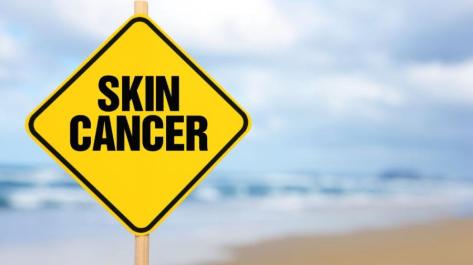SKIN CANCER AWARENESS

“Skin cancer is one of the most prevalent types of cancer. Each year, nearly 1 million Americans are diagnosed with some form of cancerous skin lesions (sores). Fortunately, skin cancer also is one of the most avoidable and treatable cancers.” (www.cancer.org) The three main types of skin cancer are basal cell carcinoma, squamous cell carcinoma, and melanoma. It is thought that these types of skin cancer are often caused by long-term exposure to ultraviolet (UV) radiation from the sun or tanning beds.
Basal cells, which produce new cells as the old ones die off, are in the outer layer of the skin. Basal cell carcinoma appears as a growth on the skin or a sore that won’t heal. It usually develops on the face, scalp, nose, eyelids, ears, legs, or arms. The lesions might have some of the following characteristics: a shiny, skin-colored bump; a brown, black, or blue lesion with a raised, translucent border; a flat scaly patch with a raised edge; or a white, waxy scar-like lesion.
Squamous cell carcinoma develops in the middle and outer layers of the skin. It is usually not life-threatening but can become aggressive if left untreated. Areas affected are the head, arms and legs, but also the tongue, throat, and stomach. Signs of this type of cancer include: a firm, red nodule; a flat sore with scaly crust; a new sore or raised area on an old scar; or a rough scaly patch on a lip.
Melanoma is the most serious type of skin cancer. It develops in the cells that produce melanin, a pigment that gives skin its color. Common areas affected are the back, legs, arms, and face. Other areas include soles of the feet, palms of the hands, and fingernail beds. Melanoma skin lesions have uneven borders; appear in shades of black, brown, or tan; or are spots that don’t heal. “The risk of melanoma seems to be increasing in people under 40, especially women. Knowing the warning signs of skin cancer can help ensure that cancerous changes are detected and treated before the cancer has spread. Melanoma can be treated successfully if it is detected early.” (www.mayoclinic.org)
The A-B-C-Ds of Skin Cancer Prevention
• A is for “avoidance.” Ultraviolet rays from the sun are most harmful between 10 AM and 4 PM. Avoid excess sun exposure during those hours. Also avoid tanning beds.
• B is for “bronzers.” These products allow one to “tan” without sun exposure, so they are safer for one’s skin.
• C is for “coverage.” Remember to wear sunscreen when out-of-doors. Use at least a 15 SPF, apply it 30 minutes before going outside, and reapply it every 90 minutes.
• D is for “detective.” Regularly examine your skin for moles or changes, especially if you have a family history of skin cancer, or if you have very fair skin.
The A-B-C-D-Es of Skin Cancer Detection
• A is for “symmetry.” Suspicious moles or lesions are ones with irregular shapes or ones where one half differs from the other half.
• B is for “border.” Have any moles or lesions checked by your physician if they have irregular or scalloped edges.
• C is for “color.” Moles or lesions with many colors, changes in color, or variations in color should also be checked.
• D is for “diameter.” Observe if the mole or lesion has a diameter greater than ¼ inch, which is about the size of a pencil eraser.
• E is for “evolving.” Have any mole or lesion checked if it looks different from the rest or is changing in size, shape, or color.
“If you notice any changes, see your health care provider. Don’t wait for the area to hurt or itch—skin cancer seldom causes pain. Most skin cancers are superficial, slow growing and highly treatable, especially if found early.” (www.cancer.org)
